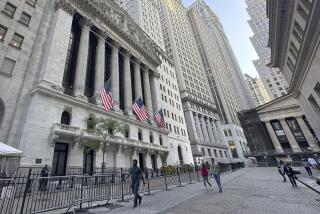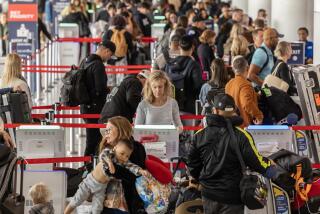Gas prices expected to fall
With stock portfolios in shock because of Wall Street’s gyrations, consumers have at least one thing to look forward to: The collapse in oil prices happening in near-tandem with the stock market blowout means that motorists should see pump prices drop as much as 50 cents a gallon over the next several weeks, energy experts said.
While that might sound like great economic news, the underlying reasons are anything but. Oil prices have fallen on expectations that the world’s economies are headed for a rough patch, which would reduce demand not only for oil and gasoline but also for employees and for things that businesses make and sell.
“Weak economies engender low oil prices,” said economist James Williams of WTRG Economics. Stock market volatility, he said, illustrates “the lack of confidence in a recovery and an increase in expectations of another recession.”
Markets zigzagged again Thursday.
A positive U.S. weekly jobs report helped ease investors’ recession fears, boosting the Dow Jones industrial average by 423.37 points, or 3.95%, to 11,143.31 after a plunge of 519 points Wednesday. The Standard & Poor’s 500 index rose 51.88 points, or 4.63%, to 1,172.64. The Nasdaq composite index jumped 111.63 points, or 4.69%, to 2,492.68. Gold futures fell 2% to $1,748 an ounce.
In New York futures trading, crude oil for September delivery slipped as low at $81.03 a barrel on French debt concerns but recovered along with equity markets to close at $85.72 a barrel, up $2.83.
Still, energy analyst Fadel Gheit called the overall decline in oil prices — down nearly $14 a barrel since late July — “a very ominous sign.”
“Oil is crashing because there is less demand for it. There haven’t been any really good economic signs that we can attribute to this,” said Gheit, senior energy analyst for Oppenheimer & Co.
The dearth of encouraging news could have another dampening effect: Nervous consumers are more likely to hold on to any extra money that lower pump prices would bring rather than spend it to help stimulate the economy.
“It’s kind of like getting a reduced price for Dodger tickets at a time when the team is kind of awful,” said Tom Kloza, chief oil analyst for the Oil Price Information Service, an energy-tracking company based in Wall, N.J.
In California, the average price of a gallon of regular gasoline was $3.76 on Thursday, down from $3.815 a week earlier, according to the AAA Fuel Gauge Report, a daily survey of fuel retailers based on credit card receipts. Nationally, the average was $3.62 a gallon, down from $3.703 a week earlier.
Earlier this week, oil dropped to its lowest levels since September, eventually closing at $79.30 a barrel, well off its high for the year of nearly $114 a barrel on the New York Mercantile Exchange. Analysts are thus predicting that the average price for gasoline in the U.S. will fall in the coming weeks, with the predicted size of the decline ranging from 30 cents to 50 cents a gallon.
“If oil remains low, the national average for gasoline will fall to $3.25 to $3.40 in the next two to three weeks as retailers slowly lower their prices to reflect their drop in cost,” said Patrick DeHaan, senior energy analyst for GasBuddy.com, a website that lists retail gasoline prices.
Though motorists would welcome such relief, some say they aren’t in a hurry to spend the savings.
“It would be nice, but I think this is such a bad economy that we are still worse off now than we were last year. We would save the money,” said Henry C. Chen, 51, a driver’s education and health teacher at Bellflower High School.
Chen considers himself lucky: He and his wife, Susan, have jobs and health benefits. But a home renovation three years ago left them short on savings.
So the couple look for the cheapest gasoline and religiously use coupons on household items. Henry Chen is nursing a 1998 Volkswagen Passat rather than shelling out for a newer car and higher insurance premiums in exchange for potentially better gas mileage.
‘We don’t want to spend money that we might need,” he said.
Consumer advocate Jamie Court is more blunt: “If the public feels it is getting ripped off at $4 a gallon, they will still have a sense that they are ripped off at $3.50.
“It may change driving habits, but it won’t change spending habits. Consumers are not going to see the other high prices they are paying being rolled back just because of this,” said Court, president of Santa Monica-based Consumer Watchdog.
The circumstances are similar for truckers.
“We will still be in a situation that is more challenging for independent drivers,” even with a significant drop in fuel prices, said Ellen Voie, chief executive of Women in Trucking Inc. in Plover, Wis. Costs have gone up across the board for rigs, tires, parts and insurance, she said.
What’s more, the fuel price break probably won’t last long, experts said.
Demand for fuel is sagging in the U.S. and Europe, but consumption is expected to grow robustly in 2012 and 2013 in Asia and Latin America. That will place greater strains on world oil supplies and potentially send prices higher again.
The Paris-based International Energy Agency predicted Wednesday that global oil demand next year would reach 91.1 million barrels a day, an increase of 1.6 million barrels a day, or nearly 2%, from 2011, with growth driven primarily by emerging economies.
Brazil’s giant Petroleo Brasileiro oil company, also known as Petrobras, expects fuel demand so strong that the company plans to build “four or five new refineries by 2020,” according to Chief Executive Jose Sergio Gabrielli. That comes as major oil companies in the U.S. are selling or closing some refineries because of weak profits.
“Our market is growing and we need to build new refineries to meet the needs of Brazilians,” Gabrielli said.
Kloza of the Oil Price Information Service said gasoline prices will probably hit bottom by November and then climb.
“The rest of the world’s appetite for oil is growing,” Kloza said. “Notwithstanding what we are seeing now, the chances for a very robust winter-spring price increase are very high.”
More to Read
Inside the business of entertainment
The Wide Shot brings you news, analysis and insights on everything from streaming wars to production — and what it all means for the future.
You may occasionally receive promotional content from the Los Angeles Times.











